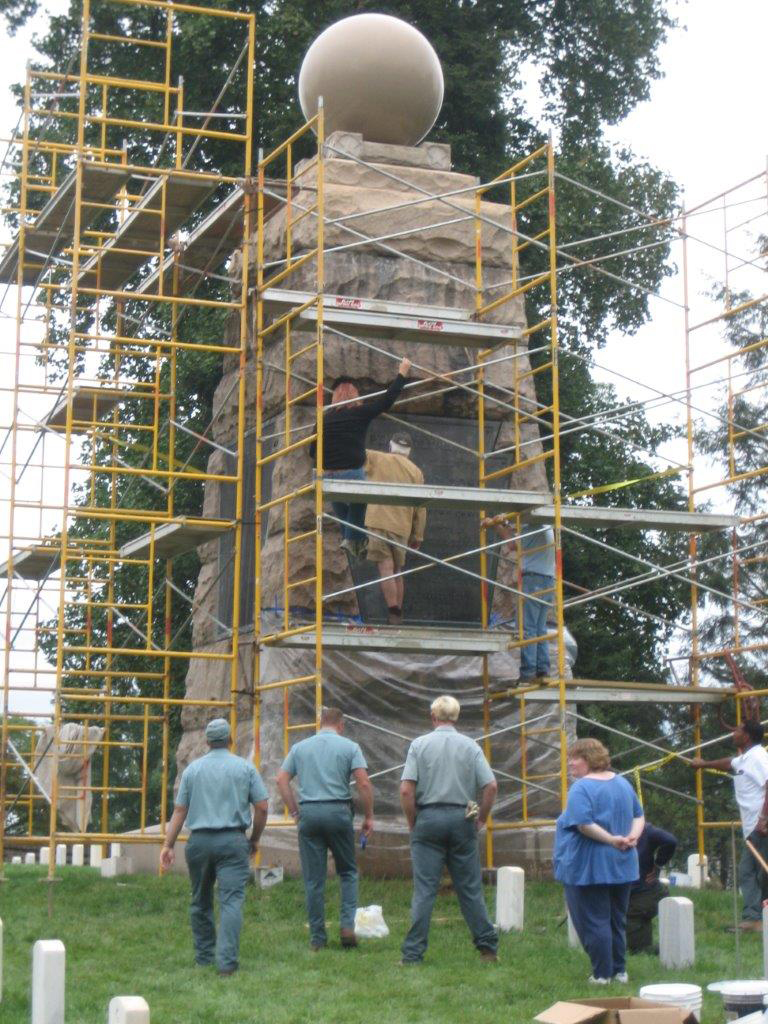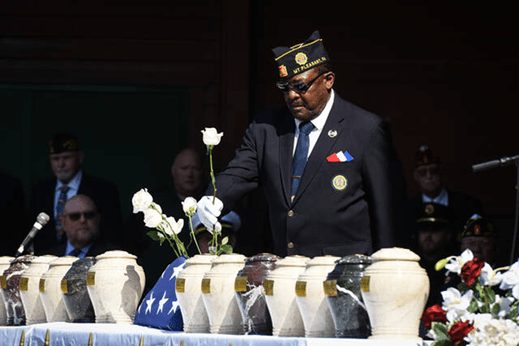National cemeteries have been shrines of our nation’s veterans’ legacy since the Civil War. Today, NCA’s senior historian, Sara Amy Leach, uses the occasion of the 50th anniversary of the National Historic Preservation Act (NHPA) to share how NCA preserves the cemeteries themselves and the beautiful monuments and structures in them for future generations of Americans.
This work is fairly technical in nature, from the research involved to exploring and developing best practices for preservation. Eventually, preservation of significant sites and structures can lead to legal protection and recognition. Sara and the team of NCA historians are right there at the vanguard of keeping the heritage of our cemeteries preserved and accessible for all.
We often proudly feature veterans’ stories here. But there are so many in NCA who contribute to preserving and sharing veterans’ legacy. NCA historians are critical members of our team. In future posts, we’ll read some more of what NCA historians have done for specific sites. But today Sara will remind us how NHPA makes so much of NCA’s preservation work possible.
[Sara’s words follow.]On October 15, 1966, the National Historic Preservation Act (NHPA) was enacted in reaction to the cultural losses associated with urban renewal. Among its many mandates are thoughtful planning processes and documentation standards to preserve America’s rich cultural assets–physically or as a permanent record. The ever-growing National Register of Historic Places (NRHP) at the National Park Service (NPS) is the official list of the country’s “historic places worthy of preservation.” Documentation of significant historic resources through written history, photography, architectural drawings, and mapping creates an essential record of what survives and what does not. The NCA History Program, in concert with VA History Preservation Office objectives, is pleased to announce substantial achievement in both areas to commemorate the 50th anniversary of the National Historic Preservation Act.
National Register of Historic Places (See the National Register of Historic Places at the NPS.)
This year, NCA has nominated numerous twentieth-century properties to the NRHP. By the end of 2016, the NPS will have recognized a total of 108 NCA national cemeteries, or 80 percent (of the current 135) as historic. Thirteen are also designated National Historic Landmarks.
NCA’s most recent NRHP listings document seven national cemeteries that represent the national cemetery system’s first post-Civil War expansion. Part of that document treats “Inter-World War National Cemeteries, 1934-1939.” After World War 1, locations for new national cemeteries were determined by areas with growing veteran populations (e.g. Texas, California). Specific sites were chosen that offered greater acreage, facilitated modern designs, and were built with contributions from New Deal programs. Meanwhile, cemeteries of this period at Veteran Health Administration campuses at Bath (NY), Bay Pines (FL), and Roseburg (OR), were listed on NCA’s recent NRHP listings as part of “Second Generation VA Medical Centers,” built in a period spanning 1919-1948. The most recently-built cemetery (1964) selected for NRHP listing is the only Veterans Administration-built cemetery in Houston, TX, Houston National Cemetery.
Individually-listed cemeteries reflect the many origins of NCA’s real estate. For example, the Army’s nineteenth-century post at Fort Marion (FL) became St. Augustine National Cemetery. The Willamette National Cemetery Willammette National Cemetery (OR) is one of three originally established to serve World War II veterans. Both were listed in 2016. Every national cemetery has a story.
Typical eligibility for listing on the NRHP requires an “historic” resource with integrity of “design, setting, materials,” and other important factors. Cemeteries may derive importance from association with historic events. There are “considerations for cemeteries, graves, commemorative properties, and resources less-than-50 years of age,” however. In 2011, the Keeper of the National Register cited Congress’s recognition of national cemeteries as “nationally significant places of burial and commemoration,” and clarified that these resources are eligible for the NRHP regardless of age.
Read the list of NCA’s nominations to the NRHP to learn more.
Historic American Landscapes Survey Documentation
The Historic American Landscapes Survey (HALS) program, sets federal standards for historic-resource documentation through written history, measured drawings, large-format photography, and, more recently, GIS mapping. The HALS Collection, organized by state, is housed at the Library of Congress (LOC). HALS fulfills NHPA’s Section 110 documentation requirements; the NCA History Program is responsible for Section 110 documentation, which creates an accurate record of the technical details of each historic site and structure, should the need for conservation or historically-accurate repair arise in the future.
Most NCA cemeteries established prior to 1973 were photographed between 2004 and 2009. They often are the first cultural landscapes accessioned into the HALS Collection for that state. The images capture buildings, monuments, structures, headstones, and vistas. Ongoing HALS documentation of NCA resources varies by subject, and to date it includes:
- 134 cemeteries: 3,186 black-and-white and 355 color 5”x7” photographs.
- Wood National Cemetery (WI), 1870, served the Northwestern Branch-National Home for Disabled Volunteer Soldiers, which is now part of a designated National Historic Landmark: 28 black-and-white photographs, 18 drawings, 50 written-history pages can be seen on the HALS page for Wood.
- Alexandria National Cemetery’s (Virginia) “tool house,” 1887: 3 drawings, 9 written-history pages can be seen at its HALS page.
Lodges were the cemetery superintendent’s office and home, and they were the most prominent building in the original cemeteries. The oldest Victorian lodge, located in Richmond, VA, dates from 1870; the last lodge was built in 1949. Today 56 historic lodges function as a residence or office.
- Research on national cemetery lodges conducted in 2012-2013 resulted in an exhaustive context and individual histories that detail associated officials, architects, builders, and occupants: 91+ written-history pages at HALS.
- Finn’s Point National Cemetery (NJ) lodge, 1877: 6 drawings at HALS.
A feature of many national cemeteries is the rostrum. Rostrums are raised and covered platforms that have been the focus of Memorial Day events for many years. The earliest was built in 1873; most have been altered or rebuilt. Today 37 historic rostrums survive.
- Research on national cemetery rostrums conducted in 2013 resulted in an exhaustive context and individual histories that details associated officials, builders, and ceremonial events: 80+ written-history pages at HALS.
- Fort Scott (KS), Richmond (VA), and the NPS Poplar Grove (VA) national cemetery lodges were drawn in 2012 to record key dimensions and features: 6 drawings at HALS.
What NHPA has done for NCA
The evolution of NCA and its significant historic landscapes is communicated through NRHP nominations and the textual and graphic documentation created for the HALS Collection. Ongoing research like this assures there will be a sound historical record that continues to grow and is accessible to the public — thanks to the National Historic Preservation Act of 1966.
Topics in this story
More Stories
As part of the Veterans Legacy Program, NCA is awarding grants for a maximum of $400,000 per awardee to qualifying educational institutions and non-profit organizations (501c3).
VA is pleased to present the "2023 VA Federal Benefits Booklet for Veterans, Dependents, Survivors, and Caregivers," a thorough guide that explains the numerous benefits to Veterans, their families and caregivers.
Every eligible Veteran deserves a dignified burial and memorialization to commemorate their service.









